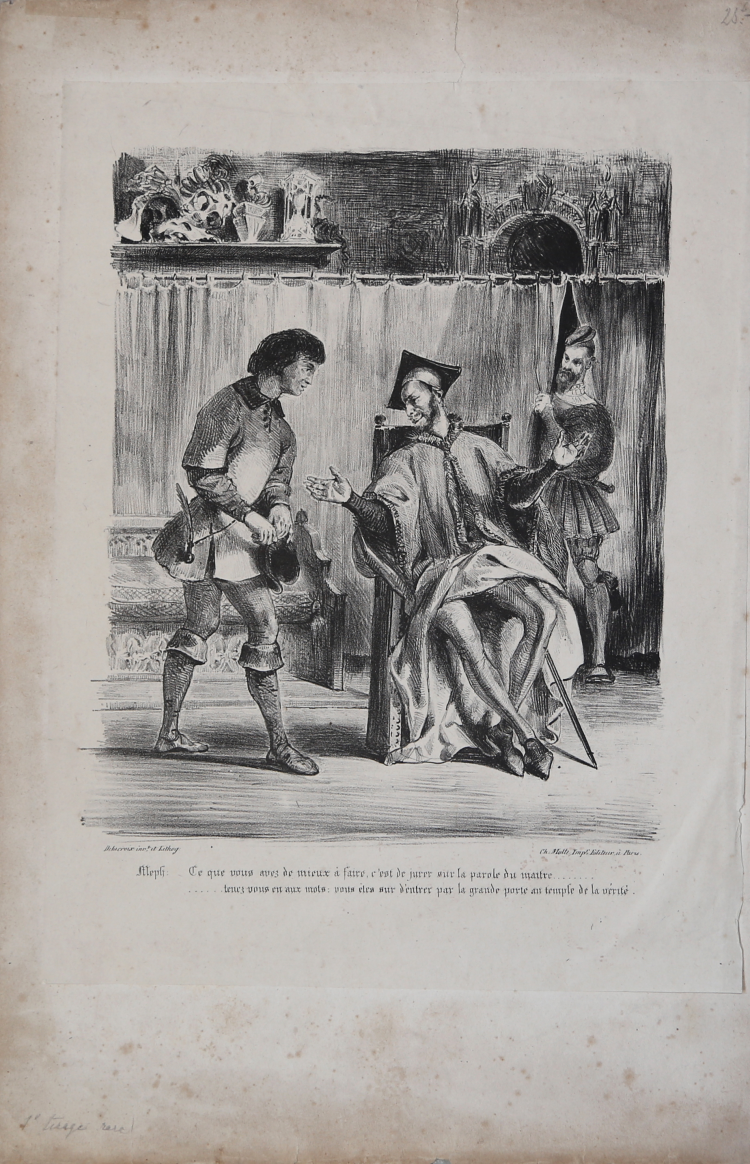



| Reference: | S5559 |
| Author | Ferdinand Victor Eugene DELACROIX |
| Year: | 1827 ca. |
| Measures: | 250 x 315 mm |


| Reference: | S5559 |
| Author | Ferdinand Victor Eugene DELACROIX |
| Year: | 1827 ca. |
| Measures: | 250 x 315 mm |
In the foreground to right, Mephistopheles, dressed in Faust's clothes, is seated and talks to the student who, mistaking him for the doctor, holds his hat respectfully in both hands; at the back of the room, Faust observes the scene, having emerged from behind a curtain (serving as a a screen), the edge of which he grasps; in the background, a laden shelf and the top of an arched doorway.
Litograph, lettered with production line: "Delacroix invt. et Lithog:", "Ch: Motte, Impr.. Editeur, à Paris", and with two lines of verse.
The original stone was lost or broken, and a copy was made for later editions of 'Faust'.
Eugène Delacroix (Charenton-Saint-Maurice 1798 - Parigi 1863), french painter, draughtsman and lithographer, was one of the towering figures of the Romantic movement and one of the last major artists to devote a large part of his career to mural painting in the heroic tradition. Lorenz Eitner (An Outline of 19th Century European Painting, 1987) describes him as ‘the last great European painter to use the repertory of humanistic art with conviction and originality. In his hands, antique myth and medieval history, Golgotha and the Barricade, Faust and Hamlet, Scott and Byron, tiger and Odalisque yielded images of equal power.’ He was the son of a diplomat, Charles Delacroix, who at the time of his son's birth was ambassador in The Hague, but it has been suggested that his natural father was the great statesman Talleyrand, a friend of the family. His mother, Victoire Oeben, was the daughter of Jean-François Oeben, one of the most distinguished furniture makers of his day. Delacroix had a good education and grew up with a love of literature and music as well as art. In 1815 he began studying with Pierre-Narcisse Guérin, who had earlier taught Géricault (whose work greatly influenced Delacroix), and the following year he enrolled at the École des Beaux-Arts. His real artistic education, however, was gained by copying Old Masters in the Louvre, where he delighted particularly in Rubens and the 16th-century Venetian painters. Throughout his life he remained a keen and perceptive student of his predecessors, and Rubens—with his richness of imagination, warmth of colour, and enormous energy—was a constant source of inspiration. In 1822 his career was brilliantly launched when his first submission to the Salon, the Barque of Dante (Louvre, Paris), a melodramatic scene from Dante's Inferno, was the talking point of the exhibition and was bought by the state. Two years later he had another success at the Salon with the Massacre at Chios (Louvre), inspired by a recent Turkish atrocity in the Greek War of Independence. It aroused much hostile criticism (Gros, who had admired the Barque of Dante, called it ‘the massacre of painting’), but it was awarded a gold medal and once again was bought by the state (with Talleyrand perhaps pulling strings in the background).
Very good condition.
|
Delteil 63 secondo stato di due.
|
Ferdinand Victor Eugene DELACROIX (Charenton S.Maurice 1798 - Parigi 1863)
|
Eugene Delacroix is numbered among the greatest and most influential of French painters. He is most often classified as an artist of the Romantic school. His remarkable use of color was later to influence impressionist painters and even modern artists such as Pablo Picasso. Born in Charenton-St-Maurice, in 1815 he became the pupil of the French painter Pierre-Narcisse Guerin and began a career that would produce more than 850 paintings and great numbers of drawings, murals, and other works.
|
|
Delteil 63 secondo stato di due.
|
Ferdinand Victor Eugene DELACROIX (Charenton S.Maurice 1798 - Parigi 1863)
|
Eugene Delacroix is numbered among the greatest and most influential of French painters. He is most often classified as an artist of the Romantic school. His remarkable use of color was later to influence impressionist painters and even modern artists such as Pablo Picasso. Born in Charenton-St-Maurice, in 1815 he became the pupil of the French painter Pierre-Narcisse Guerin and began a career that would produce more than 850 paintings and great numbers of drawings, murals, and other works.
|